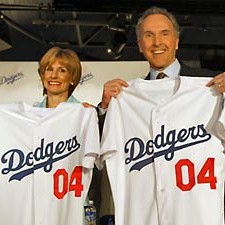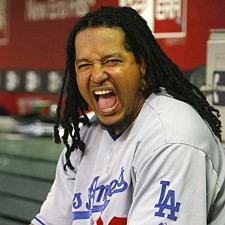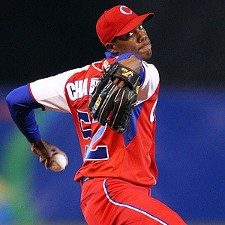INVITATIONS TO THE BIG SHOW
Sunday, February 28th, 2010Andrew Bailey and Chris Coghlan, the rookies of the year in their respective leagues last season, did not attend spring training with major league contracts or with major league roster spots. Nor did 8 of the 15 other rookies who received votes in the Baseball Writers Association election.
Ten of the top17 rookies were non-roster invitees to their teams’ spring training camps. They were part of the largest group of players ever to receive non-roster invitations to spring training.
In 2009, teams issued spring invitations to 580 non-roster players, according to the commissioner’s office. One-third of those players, 195, wound up playing at least one game in the majors. Brewers catcher Carlos Corporan, Angels’ reliever Fernando Rodriguez and Red Sox reliever Billy Traber each played in one game last season. Many non-roster players, including Bailey and Coghlan, did much better.
That group included the Pirates’ Garrett Jones and Andrew McCutchen, the Rangers’ Elvis Andrus, Gordon Beckham and Scott Podsednik of the White Sox, Nick Green of the Red Sox, the Reds’ Laynce Nix, the Diamondbacks’ Gerardo Parra and Ryan Roberts, the Cardinals’ Colby Rasmus and Joe Thurston, the Giants’ Juan Uribe and a couple of catchers, the Orioles’ Matt Wieters and the Mets’ Omir Santos.
In addition there were pitchers Tommy Hanson and Kris Medlen of the Braves, the Angels’ Matt Palmer, the Padres’ Kevin Correia, the Rangers’ Derek Holland, Daniel Bard of the Red Sox, the Giants’ Brandon Medders, the Rays’ Randy Choate, the Nationals’ Jordan Zimmerman, Chris Jakubauskas and Sean White of the Mariners, the Marlins’ Sean West and the Oakland four – Bailey, Brett Anderson, Trevor Cahill and Vin Mazzaro.
This spring a near-record 577 players are in camps throughout Florida and Arizona with non-roster invitations.
Some players are invited because of contractual obligations. As an inducement to get a draft choice to sign, a club can offer an early appearance at the major league camp. Some players are invited because they are top prospects and teams want them to get accustomed to major league spring training. Or teams simply want to see how the prospects will perform under those circumstances.
Some players are signed to minor league contracts with promise of invitations because there was no more room on the 40-man roster. Some are invited because they have been major leaguers and teams think there’s an outside chance they could win a job or at least be a Class AAA player in the minors.
And then there are those who are non-roster because they don’t have to be put on the 40-man roster yet. If they win major league jobs in spring training, they can be added to the 40-man roster by the start of the season.
 That’s what happened last spring with a quartet of Athletics’ pitchers – Bailey, who became the team’s closer, and three starters who started virtually half (79) of Oakland’s games – Anderson (at left), Cahill and Mazzaro, though Mazzaro’s elevation to the majors came two months into the season.
That’s what happened last spring with a quartet of Athletics’ pitchers – Bailey, who became the team’s closer, and three starters who started virtually half (79) of Oakland’s games – Anderson (at left), Cahill and Mazzaro, though Mazzaro’s elevation to the majors came two months into the season.
“We didn’t need to create roster spots for them just to be in spring training,” Billy Beane, the Oakland general manager, said. “If they make the team, you create a spot. If they don’t, there’s no need for a spot.”
Those pitchers were not in camp by accident. The Athletics thought they knew what they had and were giving Bailey, Anderson, Cahill and Mazzaro every chance to make the team. All were in their early 20s, and three of them had been selected in the 2005 and 2006 drafts while Anderson had been part of the Dan Haren trade with Arizona.
“We didn’t have a whole lot of choices,” Beane said. “We felt they were the future of our club but we didn’t know it was the immediate future of the team. We went in with an open mind.”
Beane acknowledged that the pitchers had the kind of growing pains young pitchers are expected to experience, but he noted that “Anderson and Cahill were 21 years old and won in double digits with a team that came in last.”
The left-handed Anderson had an 11-11 record and 4.06 earned run average in 30 starts, Cahill 10-13 and 4.63 in 32 starts and Mazzaro 4-9 and 5.32 in 17 starts. Bailey, at 24 the oldest, had a 6-3 record, 1.84 e.r.a. and 26 saves in 68 appearances.
Other non-roster pitchers flourished, none more than Hanson of Atlanta. A 22-year-old right-hander with three years in the minors, Hanson has an 11-4 record and 2.89 e.r.a. in 21 starts. He started his first game June 7, which means he was one of the players teams leave in the minors until they have missed enough major league service time that the team is saved a year of salary arbitration and free agency.
Hanson was a non-roster player because the Braves didn’t have to put him on the roster for spring training. The Angels didn’t have to open a roster spot either for Palmer because they signed the 30-year-old right-hander as a minor league free agent. In his seven-year professional career, Palmer had started three games for the Giants. With the Angels, he started 13 games and relieved in 27 others, gaining an 11-2 record with a 3.93 e.r.a.
FINALLY, A PLUS FOR THE PIRATES
From start to finish, no two hitters emerged from their non-roster spring status more impressively than a pair of Pirates. First baseman-outfielder Garrett Jones and center fielder Andrew McCutchen were two bright spots in an otherwise typically dismal Pittsburgh season, the major league record 17th consecutive losing season.
Jones, at age 28, was well on his way to becoming a career minor leaguer, having spent nearly all of his 10 professional seasons in the minors, the period of exception being a 31-game stretch in 2007 with the Twins.
A 14th-round draft choice of the Braves in 1999, Jones joined the Pirates as a minor league free agent. Accruing more time in the minors, Jones was summoned to the majors when the Pirates traded Eric Hinske to the Yankees June 30.
Jones proceeded to start 82 games (29 at first, 53 in the outfield) and hit .293 with 21 home runs and 44 runs batted in. He had a .567 slugging percentage and .372 on-base percentage, an impressive combination totaling .939.
“Our scouts identified him as a guy who was stuck behind some pretty good players,” Neal Huntington, the Pirates’ general manager, said of Jones’ signing. Huntington mentioned Justin Morneau and Michael Cuddyer as Jones’ roadblocks. “We were fortunate to sign him as a free agent and he had a fine spring, but he was behind Eric Hinske. But Garrett continued to open our eyes and we found a spot for him.”
A full-fledged member of the roster this spring, Jones is assured of an everyday job, either at first or in right. Huntington said if Jeff Clement, whom the Pirates obtained in the Jack Wilson trade last July, is ready to play first, Jones will play right. If he isn’t, Jones will play first with Ryan Church or Brandon Moss in right.
McCutchen will be the center fielder following an outstanding two-thirds of a season in which he batted .286, drove in 54 runs in 108 games and had a .471 slugging percentage and .365 on-base. The Pirates promoted the 22-year-old McCutchen June 4 when they traded Nate McLouth to Atlanta.
“Andrew was a case where he was a prospect on the rise,” Huntington said. “There was no need to put him on the 40-man roster to protect him. He continued to develop in spring training and exceeded our expectations.”
The Rangers had their own pair of non-roster players, but there was a direct connection between Elvis Andrus and Omar Vizquel. Andrus, whom the Rangers acquired from Atlanta in the Mark Teixeira trade in July 2007, didn’t have to be on the roster. Vizquel, a 20-year major leaguer, was signed to a minor league contract.
General manager Jon Daniels said he was 99 percent certain that Andrus would be their shortstop, but he signed Vizquel as a safety net.
“In case he faltered,” Daniels said, “we wanted someone to back him up and Omar was perfect.” The Rangers didn’t try to mask their intentions with Vizquel. “I talked to Adam Katz, his agent, and Ron Washington talked to Omar. We told them we expect Elvis to be the guy, but he could struggle and if he did Omar would get more playing time.”
 Andrus, only 20 when the season began, started 140 games and batted .267. He was second among American League shortstops to Orlando Cabrera in total chances. Vizquel, who turned 43 a few weeks into the season, started the 22 games Andrus didn’t.
Andrus, only 20 when the season began, started 140 games and batted .267. He was second among American League shortstops to Orlando Cabrera in total chances. Vizquel, who turned 43 a few weeks into the season, started the 22 games Andrus didn’t.
“My only disappointment,” Daniels said, “was we weren’t able to bring Omar back.” Vizquel, again a free agent, signed with the White Sox, and this time he is in camp as a member of their roster.
Nick Green is in the Dodgers’ camp as an invitee, which means Dodgers infielders should be careful. Green was in the Red Sox camp as an invitee a year ago and wound up as the starting shortstop.
“We brought him in to provide some depth for our major league middle infield,” general manager Theo Epstein said. “We thought that he was a guy who would likely go to Triple A and be the first to call up. As it turned out, one shortstop had surgery in spring training and one at the start of the season.”
Julio Lugo had a knee operation during spring training. Jed Lowrie had wrist surgery the first week of the season. Green was the beneficiary of their misfortune, starting 74 games at short, more than any of the other shortstops started. Green had not played in the majors at all in 2008.
“You look to see who fits best in your organization, who might be available,” Epstein said, discussing the way he looks for bench players.
The Cardinals had a pair of non-roster players make their team and contribute significantly, but Colby Rasmus and Joe Thurston weren’t as dynamic as Jones and McCutchen. Rasmus started 114 games in the outfield, played in 147 and batted .251 and drove in 52 runs. Thurston filled in mostly at third base, batting .225 in 124 games.
“Colby was a top-rate prospect who had suffered some injuries,” John Mozeliak, the Cardinals’ general manager, said. “so we didn’t need to put him on the roster until he made the club. If he hadn’t made the club in spring training, we would not have started the clock. Thurston was a traditional six-year minor league free agent coming off a fairly robust winter ball. We gave him an opportunity, and he took advantage of it. He had been a top-rate player in the Dodger system but never grabbed hold of a major league career.”
However, as helpful as Thurston was to the Cardinals at times last year, he didn’t grab hold of a career with them either. Thurston, in fact, is no longer with the Cardinals. They outrighted him to the minors last November, and he became a free agent. He signed with the Braves and now is – what else? – a non-roster invitee to spring training with them.
PINIELLA DOESN’T GO TWEET
 I have known Lou Piniella since he was traded to the Yankees in 1974. We have always had a good relationship, and with rare exception I have always enjoyed talking to him. When he was a veteran member of the Yankees, he was the player one or two other writers and I would seek out before the last game heading into the All-Star break to get a state of the Yankees assessment.
I have known Lou Piniella since he was traded to the Yankees in 1974. We have always had a good relationship, and with rare exception I have always enjoyed talking to him. When he was a veteran member of the Yankees, he was the player one or two other writers and I would seek out before the last game heading into the All-Star break to get a state of the Yankees assessment.
Now I have found a new reason to like Lou. There was a delightful story from the Associated Press last week about the plans of Ozzie Guillen, the White Sox manager, to set up a Twitter account. The A.P. reporter dutifully asked Piniella, Chicago’s other manager, if he planned to follow Guillen and open a Twitter account of his own.
“What is Twitter?” Piniella asked. After being informed of how it works, Piniella said, “Ozzie … he needs more space than that.” But the 66-year-old grandfather has no plans to get involved in social networking.
“First of all, I don’t know how to Twitter,” he said. “Second of all, I’m not going to learn how to Twitter. Look, I’ve heard of Facebook. Actually, it’s on my phone; I see it once in a while.”
“But I’m really not a Facebook or Twitter guy, you know?” he added. “I’m a prime rib and baked potato guy.”

 I asked Ned Colletti, the general manager, if his off-season efforts had been affected by the divorce.
I asked Ned Colletti, the general manager, if his off-season efforts had been affected by the divorce.

 Jocketty, who built the Cardinals’ 2006 World Series winner, said that he dreamed of a pitching rotation with Chapman, Johnny Cueto, Edinson Volquez, Homer Bailey and Mike Leake. Cueto, Volquez (at 26 the oldest) and Bailey are incumbent members of the rotation, and Leake was the team’s No. 1 draft choice last year.
Jocketty, who built the Cardinals’ 2006 World Series winner, said that he dreamed of a pitching rotation with Chapman, Johnny Cueto, Edinson Volquez, Homer Bailey and Mike Leake. Cueto, Volquez (at 26 the oldest) and Bailey are incumbent members of the rotation, and Leake was the team’s No. 1 draft choice last year.
 Like the Phillies, Texas swapped starters, trading Kevin Millwood (at left) to Baltimore and signing Rich Harden as a free agent. On the surface, it would seem to be an economic swap, but the figures say otherwise.
Like the Phillies, Texas swapped starters, trading Kevin Millwood (at left) to Baltimore and signing Rich Harden as a free agent. On the surface, it would seem to be an economic swap, but the figures say otherwise. new, if slightly used, to their 2010 rotations. They were traded to their teams last season and had in-season auditions, not that they needed them.
new, if slightly used, to their 2010 rotations. They were traded to their teams last season and had in-season auditions, not that they needed them.